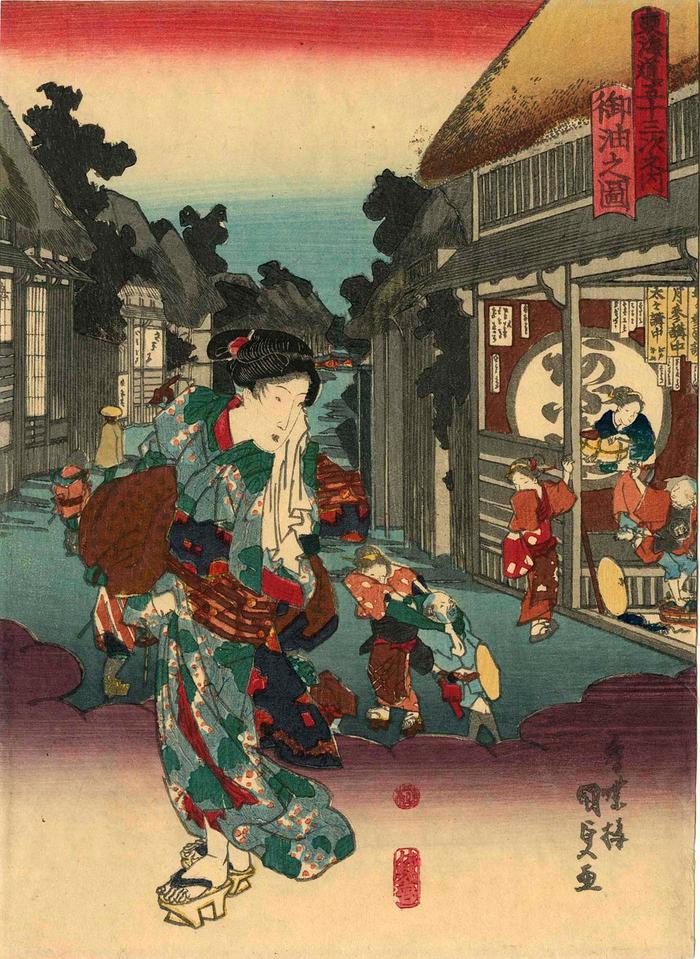Utagawa Kunisada (歌川国貞) / Toyokuni III (三代豊国) (artist 1786 – 01/12/1865)
View of Goyu (Goyu no zu: 御油之図) from the series Fifty-three Stations of the Tōkaidō Road (Tōkaidō gojūsan tsugi no uchi: 東海道五十三次之内)
ca 1838
Signed: Kōchōrō Kunisada ga (香蝶楼国貞画)
Publisher: Sanoya Kihei
Censor's seal: kiwame
Museum of Fine Arts, Boston - copy published by Moriya Jihei
Museum of Fine Arts, Boston - copy published by both Moriya Jihei and Sanoya Jihei
Honolulu Museum of Art - copy published by both Moriya Jihei and Sanoya Jihei
Museum für angewandte Kunst, Vienna
Harvard Art Museums - Hiroshige's Goyu print
National Diet Library
Spencer Museum of Art - published by Moriya Jihei
Museum of Fine Art, Boston - Hiroshige's version of this scene
Virginia Museum of Fine Art
Ishikawa Prefectural Museum of Art - they date their copy to 1836
Bryn Mawr
Honolulu Museum of Art - published by Moriya Jihei - dated ca. 1830-35
Google maps - the area of Goyu
Fujisawa Ukiyo-e Museum
Victoria and Albert Museum
Nelson-Atkins Museum of Art This is number 36 in the series, based on the earlier landscape designs by Hiroshige. The background source, loosely reinterpreted, is from Hiroshige's 1833-34 series. It is titled "Goyu: Women Stopping Travellers". The scene inside the shop on the right is different as the representation of the people gathered and struggling in the street, but the source is undeniable.
This beautiful woman may be coming from or going to a bathhouse. She has a tenugui or small towel draped over her shoulder and appears to be carrying other folded clothes with her.
Reiko Mochingda Brandon wrote on page 27 of Hokusai and Hiroshige: Great Japanese Prints from the James A. Michener Collection, Honolulu Academy of Arts: "The tenugui is a small cotton towel, approximately 13 by 35 inches, an absolute necessity for every traveler. It is an all-purpose towel, handkerchief, shoulder cloth, neck scarf, head cover, and headband. Various styles of wearing tenugui indicate masculinity, femininity, profession, age and so on."
****
The curatorial files at the Metropolitan Museum describe the Hiroshige version this way: "Information about the print series can be seen in the yellow cartouches inside the inn, which read "The Tokaido Picture—Continued," "Engraver Jirobei," "Printer, Heibei," and "Painting(s) by Ichiryūsai." (Ichiryūsai is one of Hiroshige's pseudonyms.) The large circle half-concealed by a post bears the name of Takenouchi, the publisher of the Tokaido series."
****
In Tokaido Landscapes: The Path from Hiroshige to Contemporary Artists, 2011, #36, p. 48, speaking of the original Hiroshige print it says in a text by Sasaki Moritoshi: "The print depicts the tussling on the streets of a station town in the evening. Inns line both sides of the road, and female touts called tomeonna [留女] are grabbing at a couple of travelers. The man whose face is visible is being dragged from behind and virtually strangled; he appears to have lost the strength to resist. In contrast, the young woman on the right seems to disregard the men's plight and smiles as she passes by. Inside the inn (called a hatago [旅籠] and providing food and lodging), two women and a man show little interest in what's happening on the street."
****
Muneshige Narazaki in Masterworks of Ukiyo-e: Hiroshige, the 53 Stations of the Tōkaidō (p. 67) noted: "Goyu was apparently famous for the persistence of its young women, who doubled as waitresses in the inns but who seemed to find prostitution more lucrative. Here two of them grapple for the attentions of a pair of travelers, while two other girls look on, one with rather an exasperated expression, the other presumably satisfied. Within the inn, an old woman is washing the feet of a traveler. The signboards give the name not only of one of Hiroshige's pseudonyms, which was not unusual, but also of his engraver and printer, which was rarely done. Since the modern Tōkaidō expressway does not pass through Goyu, this station still retains some of the qualities it had in Hiroshige's day - though it is doubtful that the present-day traveler will be set upon quite so brazenly."
****
Illustrated in a small color reproduction in Kunisada's Tokaido: Riddles in Japanese Woodblock Prints by Andreas Marks, Hotei Publishing, 2013, page 71, T24-36.
Sanoya Kihei (佐野屋喜兵衛) (publisher)
landscape prints (fūkeiga 風景画) (genre)
beautiful woman picture (bijin-ga - 美人画) (genre)
